
In American folklore, the axehandle hound (axhandle hound, ax-handle hound, or similar) is a fearsome critter of Minnesota and Wisconsin.

In American folklore, the axehandle hound (axhandle hound, ax-handle hound, or similar) is a fearsome critter of Minnesota and Wisconsin.
The animal resembles a dog with a body axe-like in shape. It has a head shaped like an axe blade, hence the name, complemented by a handle-shaped body atop short stubby legs. It subsists on a diet consisting entirely of the handles of axes which have been left unattended. [1] A nocturnal creature, [2] the axehandle hound travels from camp to camp searching for its next meal. [3] According to folklore, the axehandle hound strongly dislikes axe handles made from red oak. [2]
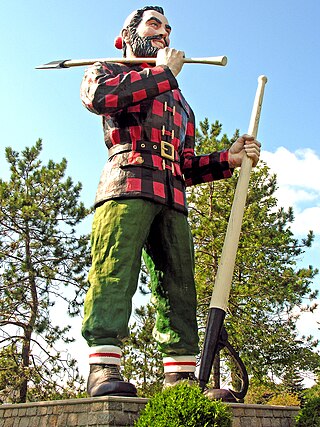
Paul Bunyan is a giant lumberjack and folk hero in American and Canadian folklore. His tall tales revolve around his superhuman labors, and he is customarily accompanied by Babe the Blue Ox, his pet and working animal. The character originated in the oral tradition of North American loggers, and was later popularized by freelance writer William B. Laughead (1882–1958) in a 1916 promotional pamphlet for the Red River Lumber Company. He has been the subject of various literary compositions, musical pieces, commercial works, and theatrical productions. His likeness is displayed in a number of oversized statues across North America.

In American folklore, a Sidehill gouger is a fearsome critter adapted to living on hillsides by having legs on one side of their body shorter than the legs on the opposite side, having evolved to resemble any form of mammals such as pangolins, goats, humans, and bears. This peculiarity allows them to walk on steep hillsides, although only in one direction; when lured or chased into the plain, they are trapped in an endless circular path. Some claim these creatures play a large role in, and in some cases are responsible for, the creation of hoodoos. The creature is variously known as the Sidehill Dodger, Sidehill Hoofer, Side-hill Gazink, Sidehill Ousel, Sidehill Loper, Sidehill Galoot, Gyascutus, Sidewinder, Wampus, Boofum, Gudaphro, Hunkus, Rickaboo Racker, Prock, Gwinter, or Cutter Cuss.
American mythology is the body of traditional stories pertaining to America's most legendary stories and folktale, dating back to the late 1700s when the first colonists settled. "American mythology" may also refer to the modern study of these representations, and to the subject matter as represented in the literature and art of other cultures in any period.
A snipe hunt is a type of practical joke or fool's errand, in existence in North America as early as the 1840s, in which an unsuspecting newcomer is duped into trying to catch an elusive, nonexistent animal called a snipe. Although snipe are an actual family of birds, a snipe hunt is a quest for an imaginary creature whose description varies.

In American folklore, the hodag is a fearsome critter resembling a large bull-horned carnivore with a row of thick curved spines down its back. The hodag was said to be born from the ashes of cremated oxen, as the incarnation of the accumulation of abuse the animals had suffered at the hands of their masters. The history of the hodag is strongly tied to Rhinelander, Wisconsin, where it was claimed to have been discovered. The hodag has figured prominently in early Paul Bunyan stories.
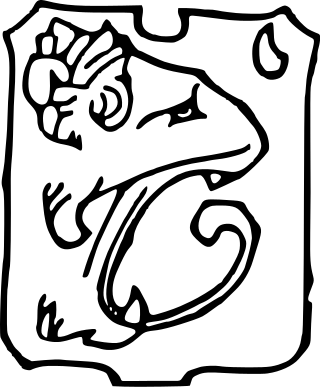
Fearsome Creatures of the Lumberwoods, With a Few Desert and Mountain Beasts is a 1910 fantasy field guide by William Thomas Cox (1878–1961), Minnesota’s first State Forester and Commissioner of Conservation, with illustrations by Coert du Bois and Latin classifications by George Bishop Sudworth The text is a noteworthy resource on folklore, as a century after its initial publication Fearsome Creatures remains one of the principal sources on legendary creatures of the United States and Canada.
The splintercat is a legendary fearsome critter in the folklore of the United States.
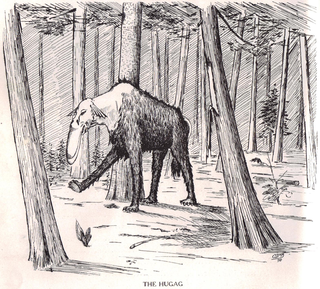
In North American folklore and American mythology fearsome critters were tall tale animals jokingly said to inhabit the wilderness in or around logging camps, especially in the Great Lakes region. Today, the term may also be applied to similar fabulous beasts.
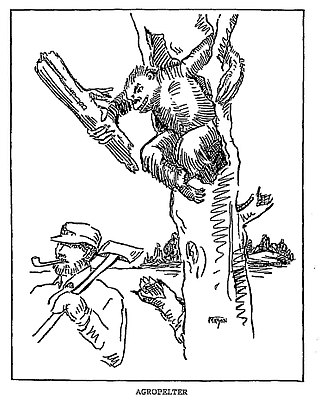
The Agropelter is a mythical fearsome critter said to inhabit hollow trees of the conifer woods from Maine to Oregon. From this vantage point, the creature would await an unwary person and hurl wooden splinters and branches at the intruder. Some have described the creature as being so quick that it has never been seen. One reference describes the creature as having a "slender, wirely body, the villainous face of an ape, and arms like muscular whiplashes, with which it can snap off dead branches and hurl them through the air like shells from a six inch gun."

The Hidebehind is a nocturnal fearsome critter from American folklore that preys upon humans that wander the woods, and was blamed for the disappearances of early loggers when they failed to return to camp. As its name suggests, the Hidebehind is said to be able to conceal itself. When an observer attempts to look directly at it, the creature quickly hides behind an object or behind the observer and therefore cannot be directly seen. The Hidebehind supposedly uses this ability to stalk human prey without being observed and to attack them without warning. Said victims, including lumberjacks and others who frequent the forests, are then dragged back to the creature's lair to be devoured. The creature subsists chiefly upon the intestines of its victim and has a severe aversion to alcohol, which is therefore considered a sufficient repellent. Tales of the hidebehind may have been used as an explanation of strange noises in the forest at night. Early accounts describe Hidebehinds as large, powerful animals, despite the fact that no one was able to see them.

The Minnesota–Wisconsin football rivalry is an American college football rivalry between the Minnesota Golden Gophers and Wisconsin Badgers. It is the most-played rivalry in the NCAA Division I Football Bowl Subdivision, with 133 meetings between the two teams. The winner of the game receives Paul Bunyan's Axe, a tradition that started in 1948 after the first trophy, the Slab of Bacon, disappeared after the 1943 game when the Badgers were supposed to turn it over to the Golden Gophers. Minnesota and Wisconsin first played in 1890 and have met every year since, except for 1906. Wisconsin leads the series 63–62–8 through 2023. Wisconsin took the series lead for the first time after defeating Minnesota 31–0 in the 2017 game; Minnesota had led the overall series since 1902, at times by as many as 20 games.
The glawackus is one of the fearsome critters, a group of legendary creatures in the folklore and traditions of lumberjacks during the 19th and early 20th centuries in North America. The glawackus is described as looking something between a bear, a panther, and a lion. The glawackus is also known as the northern devil cat. It is known for its fearsome screech that compares to the cackle of a hyena. The creature is blind and uses its sense of smell as well as sound waves. Looking into the creature's eyes is said to wipe the victim's memory. It was seen in 1939 in Glastonbury, Connecticut.

Invented traditions are cultural practices that are presented or perceived as traditional, arising from the people starting in the distant past, but which in fact are relatively recent and often even consciously invented by identifiable historical actors. The concept was highlighted in the 1983 book The Invention of Tradition, edited by Eric Hobsbawm and Terence Ranger. Hobsbawm's introduction argues that many "traditions" which "appear or claim to be old are often quite recent in origin and sometimes invented." This "invention" is distinguished from "starting" or "initiating" a tradition that does not then claim to be old. The phenomenon is particularly clear in the modern development of the nation and of nationalism, creating a national identity promoting national unity, and legitimising certain institutions or cultural practices.
Kemp Morgan or Gib Morgan is a character from American folklore, particularly appearing in tall tales.
In American folklore, the Gumberoo is a fearsome critter with hide so tough that bullets bounce off of it.

The Goofus bird is a mythical, backwards-flying bird, originating in lumberjack folklore in North America. It is also known variously as the Filla-ma-loo bird or the Flu-fly bird.
In American folklore, the gillygaloo bird is a fearsome critter that nest on hillsides and lays square eggs, so they will not roll. The eggs are also spotted giving them the characteristics of dice if hard-boiled.
In American folklore, the snow snake is a fearsome critter that, unlike other reptiles, can live in cold temperatures and is only active during winter months.

In American folklore, the hugag is a fearsome critter similar to a moose with an extensive upper-lip, preventing it from grazing, and joint-less legs preventing it from lying down.
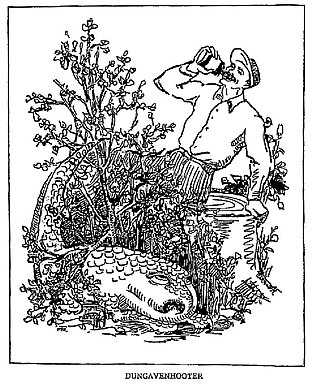
In American folklore, the dungavenhooter is a fearsome critter akin to a large crocodylian animal, lacking a mouth, which consumes prey by pulverizing its victims into a fine powder and snorting them through a set of large nostrils.